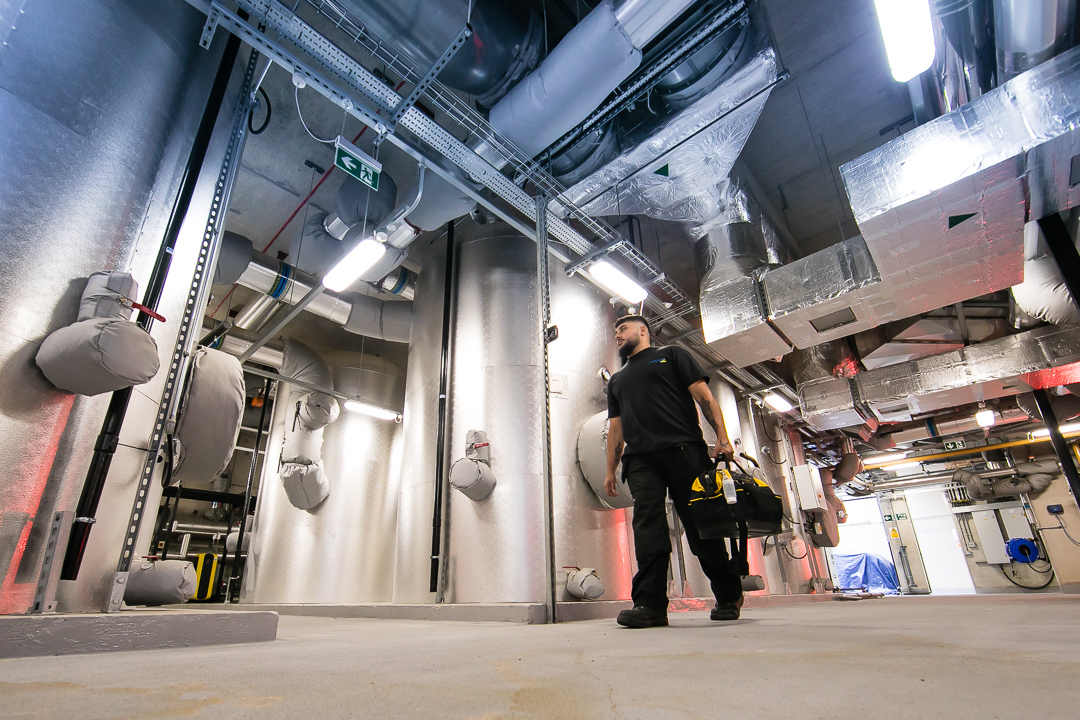In an article first published by Heating and Ventilating Review magazine, Ian Allan, Head of Market Strategy for Switch2, explains how heat network owners and operators can tackle poor efficiency on communal heat schemes
Many of the UK’s existing 17,500 heat networks are operating at low efficiency levels of only 35 to 45% – resulting in poor cost and carbon performance. That’s in stark contrast to the best performing legacy schemes, which can reach 65% efficiency.
The good news is that there’s great potential to raise efficiency, improve reliability and cut costs & carbon emissions. This can be achieved by taking a strategic approach to operations and maintenance (O&M).
Raising efficiency is the most effective way to tackle three key challenges of: reducing rising energy and operational costs; cutting carbon emissions, and complying with new regulations.
1. Reduce costs
The current energy crisis means that investing in heat network maintenance and efficiency improvements can deliver much bigger and faster cost reduction than before. Crucially, this helps to improve affordability for residents and reduce the risk of fuel poverty.
At current gas prices of around 7.5p per kWh, a typical 300-unit apartment building could reduce overall costs by between £59,000 and £110,000 annually. This would be achieved by using a specialist heat network O&M specialist, such as Switch2, to drive efficiency improvements via a data-driven, performance managed O&M regime.
Our clients pay the same for this specialist, data-informed O&M service as they would for a standard service – provided by a traditional gas engineer. The savings, both monetary and carbon, soon add up and deliver rapid investment payback.
Use our efficiency calculator to add up the cost & carbon savings for your heat network
2. Reduce carbon and gain compliance
Wasting less energy via improved efficiency has the double benefit of decreasing carbon emissions, as well as costs.
It is critical that existing heat networks are fully optimised and operating at low temperatures and maximum efficiencies in readiness for reaching net zero by 2050. These standards are essential to replacing gas boilers and combined heat and power systems with lower and zero carbon technologies, such as heat pumps.
In this way, the sector will advance decarbonisation further and prepare for major expansion of the communal heating sector – to supply 18% of homes by 2050.
Communal heat suppliers must also be ready to comply with major regulation and new technical standards, which require a much better efficiency and environmental performance, as well as improved customer service and reliability standards.
4 ways to better heat network performance
Many heat networks underperform because data intelligence is lacking and issues are hidden until they become problems. Maintenance tends to be reactive and piecemeal with no consideration for the overall efficiency of the heating system. By contrast, high performing communal heating systems take a holistic and strategic approach to O&M. The essentials of a progressive O&M strategy are:
1. Use data intelligence to inform and drive targeted, proactive maintenance. Capture data from meters, BEMS, HIUs etc and use remote monitoring to understand the performance of entire network – from plant room to properties. Accessible data is centralised, rather than sitting in silos.
2. Appoint one single specialist heat network O&M contractor who has an expert overview of entire network performance and efficiency improvements. They will be able to monitor, analyse and proactively resolve issues and provide guidance and support on improving standards
3. Implement an ongoing improvement plan with costed interventions. This should be output based, with KPIs fully considered and budgeted.
4. Communicate the importance of O&M to residents. Customers play a crucial role in improving efficiency via their energy consumption behaviours and in helping to provide feedback on system performance. Their cooperation in permitting access to properties is essential to system optimisation.
Benefits of strategic O&M:
• Reduced operating and energy costs for heat suppliers
• Lower tariffs and improve affordability for residents – reducing risk of fuel poverty
• Improve reliability and customer service
• Reduce plant room and wider network maintenance costs
• Decrease wear-and-tear on assets, prolong plant lifecycles and decrease replacement costs
• Reduce carbon emissions to prepare for a net zero future
• Compliance with new regulation for technical standards for heat networks
Efficiency in action
Switch2’s O&M contract for London’s Greenford Quay heat network uses our next generation digital technologies to optimise network performance and take a data-driven approach to efficiency improvement.
The results over 12 months include:
• 40% increase in heat efficiency
• CO2 savings of 300 tonnes
• 30% improvement in overall thermal (heat) efficiency
• 37% reduction in property heat losses of first apartment block
• Lower resident tariff charges
Are you doing enough for your residents on heat network?
Taking a holistic, data-driven approach to long term heat network performance improvement can yield positive results with lasting impact. Crucially, this specialist O&M service can be delivered at the same cost as standard, fragmented services.
Add up the cost and carbon savings you could make at your heat network by using our efficiency calculator.


